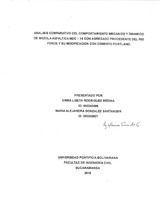| dc.contributor.advisor | Torrado Gómez, Luz Marina | |
| dc.contributor.author | Rodríguez Medina, Emma Liseth | |
| dc.coverage.temporal | 2019 | |
| dc.date.accessioned | 2020-09-29T19:22:48Z | |
| dc.date.available | 2020-09-29T19:22:48Z | |
| dc.date.issued | 2019 | |
| dc.identifier.uri | http://hdl.handle.net/20.500.11912/6120 | |
| dc.description | 75 páginas | spa |
| dc.description.abstract | El presente proyecto consistió en la evaluación del comportamiento mecánico y dinámico de mezcla asfáltica MDC-19, con agregados del Río Fonce. La metodología utilizada estuvo enfocada hacia la caracterización de los agregados y del asfalto mediante los ensayos de laboratorio, según las especificaciones del Instituto Nacional de Vías (INVIAS 2013) y posteriormente la evaluación de las propiedades mecánicas y dinámicas de las mezclas asfálticas. En la mezcla convencional su contenido de asfalto varió cada 0.5% en el intervalo de 4% a 6%, para el cual se analizaron los resultados de estabilidad, porcentaje de vacíos y densidad Bulk con el fin de establecer el porcentaje óptimo de asfalto para ser utilizado en el diseño de la mezcla modificada. Una vez determinado el porcentaje óptimo de asfalto, se procedió a realizar la mezcla modificada con cemento portland en porcentajes de 0% al 100%, de los agregados finos del diseño, variando cada 25% con el fin de determinar su respectiva estabilidad, flujo y densidad. Para finalizar se elaboraron 5 briquetas de igual proporción de cemento portland y asfalto descritas anteriormente, haciendo uso del compactador giratorio, llegando a determinar los módulos dinámicos de las mismas por medio de la DTS — 30 siguiendo los parámetros de la norma AASHTO TP — 62-03 variando tres veces la temperatura a 15°C, 25°C, y 35°C. | spa |
| dc.description.abstract | The present project consisted in the evaluation of the mechanical and dynamic behavior of asphalt mix MDC-19, with aggregates from the Fonce River. The methodology used was focused on the characterization of aggregates and asphalt through laboratory tests, according to the specifications of the National Institute of Roads (INVIAS 2013) and later the evaluation of the mechanical and dynamic properties of asphalt mixtures. In the conventional mixture, its asphalt content varied every 0.5% in the range from 4% to 6%, for which the stability, vacuum percentage and Bulk density results were analyzed in order to establish the optimum percentage of asphalt to be used in the design of the modified mixture. Once the optimum percentage of asphalt was determined, the modified mixture was made with Portland cement in percentages from 0% to 100%, of the fine aggregates of the design, varying every 25% in order to determine their respective stability, flow and density. Finally, 5 briquettes of the same proportion of Portland cement and asphalt described above were made, making use of the rotary compactor, getting to determine the dynamic modules of them by means of the DTS - 30 following the parameters of the AASHTO TP - 62 - standard. 03 by varying the temperature three times to 15 ° C, 25 ° C, and 35 ° C. | eng |
| dc.format.mimetype | application/pdf | |
| dc.language.iso | spa | |
| dc.publisher | Universidad Pontificia Bolivariana | spa |
| dc.rights | Attribution-NonCommercial-NoDerivatives 4.0 International | * |
| dc.rights.uri | http://creativecommons.org/licenses/by-nc-nd/4.0/ | * |
| dc.title | Análisis comparativo del comportamiento mecánico y dinámico de mezclas asfálticas mdc - 19 con agregado procedente del río fonce, y su modificación con cemento portland | spa |
| dc.type | Trabajo de grado | spa |
| dc.publisher.department | Escuela de Ingenierías | spa |
| dc.publisher.program | Ingeniería Civil | spa |
| dc.type.hasVersion | publishedVersion | spa |
| dc.description.sectional | Bucaramanga | spa |
| dc.description.degreename | Ingeniero Civil | spa |


